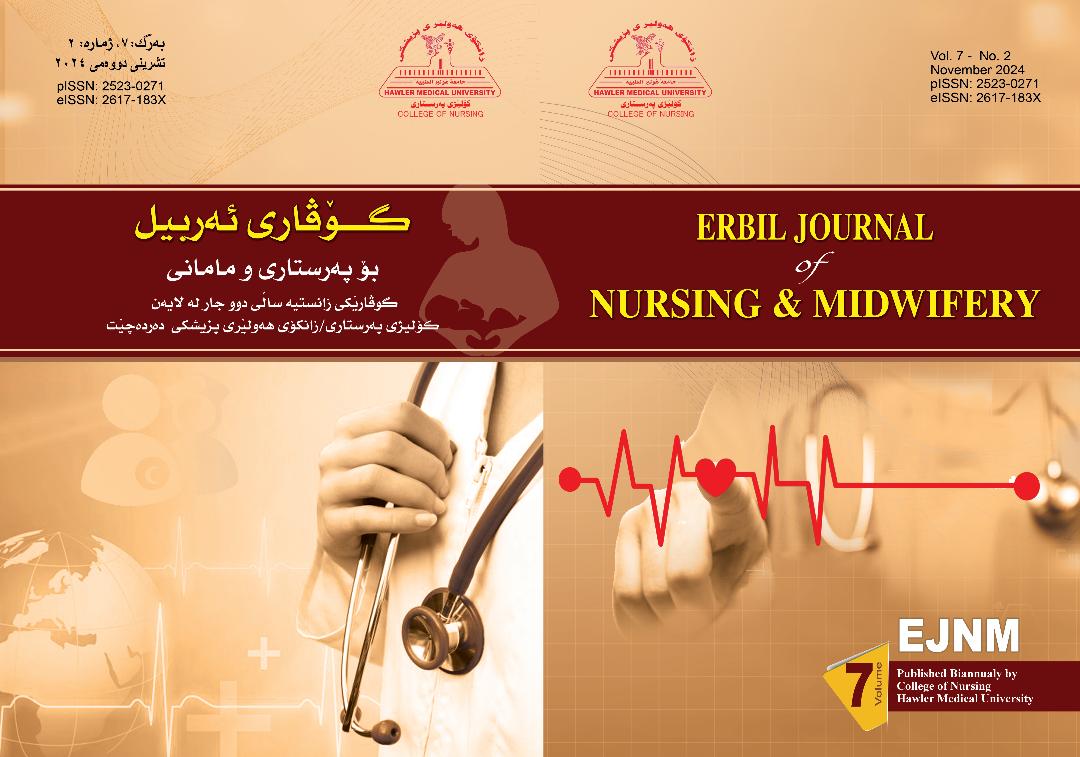Assessment of Mother’s Information and Practice, and Factors Associated Infantile Colic in Erbil City
DOI:
https://doi.org/10.15218/ejnm.2024.17Keywords:
Infant, Newborn, Infantile Colic, Information, Practice, Factors, MothersAbstract
Background and objectives: An excessive crying of unknown cause, the most common presentation to the primary health sector in early life, known as infantile colic, affects more than 20% of infants. Parents must deal with the terrible situation to resolve it spontaneously after the first three to four months of life. The study aimed to assess the mothers’ information and practices about infantile colic in Erbil city.
Methodology: This descriptive cross-sectional study was conducted on 60 mothers who attended treatment and routine follow-ups in the outpatients of primary health care centers in Erbil city. The data was collected from the 1st of June to the 30th of November 2022, through direct interviews (face-to-face) using a questioner checklist. The data were analyzed by using SPSS (24 version) to analyze the data inferentially (frequency and percentage) and to find out the association between dependent and independent variables, the Chi-square was used to identify the factors behind their practice and knowledge of the linear regression test was used.
Results: According to the study's findings, the majority (70%) of the sample were within average gestational ages (37 or more weeks). The highest percentages (70%) were within 2 months of age. There was a very highly significant association between the infant’s ages, period of crying, residency, and mother’s levels of information about the baby’s crying; also, there was a significant association between the mode of feeding and levels of the mother’s practice about infantile colic. Linear regression found that demographic variables explain a significant amount of the variance in the mothers` information. The analysis shows that infant age and period of crying were significantly associated with the mothers` information; it was found that demographic variables explain a significant amount of the variance in the mothers` practice......
Metrics
References
Sung V. Infantile colic. Australian Prescriber Journal. 2018 Aug; 41(4): 105–110. Published online 2018 Aug 1. doi: 10.18773/austprescr.2018.033: PMCID: PMC6091773.
Al-Shehri H, Al-Mogheer B.H, Al-Sawyan T.H, Abualalaa A.B, Jarrah O.A, Jabari M et al . Assessment of maternal information about infantile colic in Saudi Arabia. Electron Physi-cian. December 2016, Volume: 8, Issue: 12, Pages: 3313-3317, DOI: http://dx.doi.org/10.19082/3313. (ISSN: 2008-5842).
Dobson D, Lucassen PL, Miller JJ, Vlieger AM, Prescott P, Lewith G. Manipulative therapies for infantile colic. Cochrane Database Sys-tem Rev. 2012; 12: CD004796. doi: 10.1002/14651858.cd004796.pub2. PMID:23235617.
Bagherian B, Mehdipour-Rabori R, Nematollahi M. How Do Mothers Take Care of Their Infants with Colic Pain? A Mixed-Method Study. Ethiopian Journal Health Science. 2021;31 (4):761. doi:http://dx.doi.org/10.4314/ejhs.v31i4.10.
Mansourzadeh AR, Sirati Nir M, Najafi Mehri S. Living with a Colicky Infant: Meta-synthesis of Qualitative Studies. Intentional Journal of Pediatric 2016; 4(8): 2311-16. http:// ijp.mums.ac.ir.
Benninga MA, Faure C, Hyman PE, St James Roberts I, Schechter NL, Nurko S. Childhood Functional Gastrointestinal Disorders: Neo-nate and Toddler. Gastroenterology Jour-nal:2016, S0016- 5085(16)00182–7. 15; S0016-5085(16)00182-7. doi: 10.1053/j.gastro.2016.02.016.
Ünal E.T,Bülbül A, Elitok G.K, Avşar H, Uslu S . Evaluation of the Information Level and Attitude of Mothers About Infantile Colic. Haydarpasa Numune Medical Journal. DOI: 10.14744/hnhj.2020.47135 2021;61(1):38–44.
Rad Z.A , Mojaveri M.H, Pasha Y.Z, Kacho M.A, Kamkar A, Khafri S et al .The Effects of Kangaroo Mother Care (KMC) on the Fuss and Crying Time of Colicky Infants. Iranian Journal of Neonatology; (2015). 6(1). 10.22038/ijn.2015.4152
Viechtbauer W., Smits L., Kotz D., Budé L., Spigt M. and Serroyen J, et al. R. A simple formula for the calculation of sample size in pilot studies. Journal of Clinical Epidemiology, (2015). 68, 1375-1379.
Talachian E, Bidari A, Rezaie MH. Incidence and risk factors for infantile colic in Iranian infants. World Journal Gastroenterol 2008; 14(29): 4662-4666 [PMID: 18698680 DOI: 10.3748/wjg.14.4662].
Khajeh M, Sadeghi T, Ramezani M, Derafshi D . effect of mothers' educational supportive care program on the pain intensity and crying caused by colic in infants aged 1-5 months. Evidence Based Care Journal, 2019, 9(1): 7-15. Downloaded from http://ebcj.mums.ac.ir/.
Kries R.V, Kalies H, Papoušek M (2006). Excessive Crying Beyond 3 Months May Herald Other Features of Multiple Regulatory Problems. Archives of pediatrics & adolescent medicine journal. 2006;160(5):508-511. doi:10.1001/archpedi.160.5.508.
Saeidi R, Abadi M.Z , Saeidi A, Robatsangi M.Gh (2014). The Effectiveness of Mother Infant Interaction on infantile colic. Iranian Journal of Neonatology 2014; 38. 1997; 71(4):862–77. 22.
Turner T.L, Palamountain Sh, Augustyn M, Torchia M.M . Patient education: Colic (excessive crying) in infants (Beyond the Basics). Journal of Clinical Nursing .2021, Topic 1205 Version 16.0. DOI: 10.1111/jocn.16097.
Didişen N.A, Yavuz B, GerçekerO.G, Albayrak T, Meryem Atak M, Başbakkal D.Z. Infantile Colic in Infants Aged One-Six Months and the Practices of Mothers for Colic. Journal Pediatric Research. 2020;7(3):223-9. DOI: 10.4274/jpr.galenos.2019.72687.
Wal D.V, Boomb D.V, H Pauw-Plomp H ,G A de Jonge D.GA. Mothers’ reports of infant crying and soothing in a multicultural population.1998, V 79, Issue 4 :ISSN 1468-2044Print: ISSN 0003-9888.
Despriee W.A, Mägi C.A, Småstuen M.C, Glavin K, Nordhagen L, Jonassen Ch.M, et al (2021). Prevalence and perinatal risk factors of parent-reported colic, abdominal pain and other pain or discomforts in infants until 3 months of age - A prospective cohort study in Prevent ADALL. Journal of Clinical Nursing. Pub Date: 2021-10-26, DOI: 10.1111/jocn.16097.http://dx.doi.org/10.19082/3313. (ISSN: 2008-5842).
Chalabi D.K, Omer K, Al-Taweel N. Risk fac-tors for infantile colic: a case-control study. Journal of the Arab Board of Health Specialisations (2016). Vol.17, No.2, 2016 https://www.researchgate.net/publication/315722616
Ölmestig T.K, Siersma V, Birkmose A.R, Kragstrup J, Ertmann R.K . Infant crying problems related to maternal depressive and anxiety symptoms during pregnancy: a prospective cohort study. BMC Pregnancy and Childbirth 2021,21:777. https://doi.org/10.1186/s12884-021-0425.
JN Critch. Infantile colic: Is there a role for dietary interventions? Pediatrics & child health journal (2011). 16(1): 47–49. PMCID: PMC3043028.
Downloads
Published
How to Cite
Issue
Section
License
Copyright (c) 2024 Gulala Kareem Azeez, Abbas Abdulqader Ahmed Rabaty, Shukir Saleem Hasan (Author)

This work is licensed under a Creative Commons Attribution-NonCommercial-ShareAlike 4.0 International License.



















